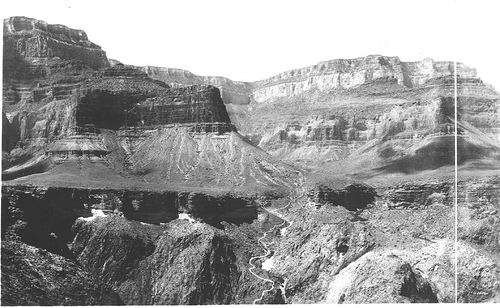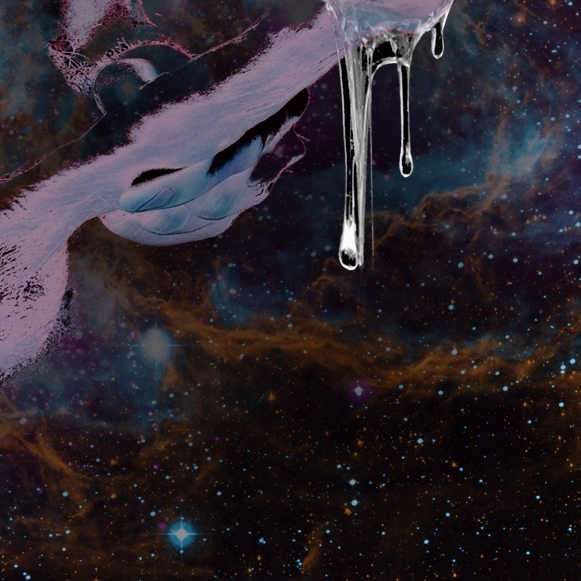The Deserts’ Kiss
Not all of nature’s demons are animals, you know. Sometimes it’s not just the gremlins that glower in the grove, but the greenery itself. You’ve probably all heard of the butterfly-eating cobra lilies in the Oregon boglands, or the common venus flytrap in North Carolina’s Green Swamp, or even the tree mushrooms that live in any woods you’ll find, suckling nutrients out of the rotting corpses of their plant-kin… but in the plateaus skirting America’s Great Inland Deserts, an altogether darker fear is budding.
If you’re lucky enough to see Joshua Tree Park someday (and I hope you do; though it’s not one of the best of our National Parks, it’s certainly one of the most disconcerting— an entropic dry wild with none of the familiar flora or fauna to rest your eyes upon), do take the time to drive south through the park, heading down into the Pinto Basin where, just as the Mojave desert kisses the Sonora, off the to side of the road you’ll find an acre of Mars right here on Earth– the great Cholla Cactus garden. As you walk along the shadeless boardwalk, you’ll notice the laughter punctuated by an “Ouch! Dang it!” every few minutes as this “jumping cactus” earns its nickname, darting painful spines into anyone dumb enough to threaten a loving stroke on the lush teddybear stalks. Go ahead and laugh with the other tourists— the Jumping Cholla is a cute reminder that it’s not just animals who can attack, after all. But know that the Cholla Cactus is little more than a terrier puppy when compared to its hungry wolf cousin, Cylindorpuntia Sicarius: the Assassin Cactus.
Unfortunately, there’s not much that can be said about the Assassin Cactus; anyone who’s set off into San Jacinto’s eastern foothills trying to find it has never returned. But if you hang out in the diners and dive-bars of Cochella or Indio long enough, you’re likely to hear an old-timer—a daughter or maybe even a son of one of the families who came with the railroad—tell of a cousin or a neighbor or a high school sweetheart who once had a ill-fated run-in with the blooming beast. Everyone in the desert has a story, it seems, but no story is sadder than that of Bonnie Rector.
Though you won’t find her name in any history books today, Bonnie Rector was once one of the most powerful women in the Old West. A daughter of the earliest white colonists of Iowa, she was one of the first women allowed into Iowa Weslyan University, where she graduated with highest honors in both Botany and Organic Chemistry. Ever the adventurous spirit, Ms Rector headed to San Diego in the late 1880s in search of new kinds of flower to bring new fragrances to the dazzling 20th Century waiting just around the corner (in some versions of the story, it’s she who brought the first Birds of Paradise to Southern California). In her search for exotic flowers, Ms Rector hired a local Kumeyaay guide—a native beauty called Jael in most versions of the story, though sometimes spelled Jeil and occasionally Djielle—to show her the land as only those who’d long been there would know it, and in their hunt for inland orchids and other fantastic Borrego botanicals, an unexpected love began to bloom.
It was Fall of 1901 and the Pan-American Exposition in Buffalo had been the biggest and brightest World’s Fair yet, and every company from Missouri-Pacific to Wrigley had already started gearing up to make the next one in St. Louis even better. While at the fair, Bonnie, true to her nature, had loudly and publicly expressed disappointment for the lackluster botanical display of—as she called it—“the same old vines and pines from Britannica”. Well, half calling her bluff and half publicity stunt, she was hired then and there by Southern Pacific Railroad, signing a contract on the bow of Solcum’s ship for what was supposed to become the next fair’s greatest attraction—“Bonnie, Bring Us Beauty!”— a collection of the rarest and most exotic flora: never before seen or smelled plants, trees, fruits, and flowers—with Southern Pacific promising to build a giant jewel box of a greenhouse in the heart of St. Louis’s future exposition park if Bonnie could find a singular jewel of a flower worthy of its showcase.
It was on that long train ride back across the US that Bonnie and Jael realized what had really happened during all those long hours they’d spent in the hills, how they found more than plants while hiking the forests, valleys, and dunes of Southern California, how all those shared nights beneath the stars had turned their partnership into the rarest flower of all— the love of equals. As their private dining car crossed back into California territory, Jael proposed marriage: spend eternity together, grow with each other as the yucca grows with the desert. And Bonnie accepted, on one condition— their wedding would have to wait until after she’d found the perfect centerpiece flower, the crowning bloom for the Southern Pacific exhibition, her St. Louis Jewel.
As the months passed and fall turned to winter, Bonnie slowly withdrew from society, spending week upon week in the wild, shunning society parties in favor of lone walks in the dangerous low-country, as her search for some great undiscovered flower turned from desire to compulsion and finally to a singular obsession, her own white whale. It wasn’t long before this siren song of the wilderness left her deaf even to Jael’s pleas and the bed they shared grew increasingly cold. By the second or third time Bonnie had gone into the desert alone—leaving no explanation, no note, no hint of when or if she’d return—Jael had finally had enough.
There was an old Digueño legend about a most lovely bloom called The Deserts’ Kiss— a pearlescent double-headed flower with petals as red as blood around two glittering orange seed-heads, a flower that turned to a shimmering flamingo pink and bright lemon yellow in the fullness of the midday sun and deepened to hues of bruised purple, the indigo of fresh ink, and a sienna as vibrant as a Colorado riverbed in the cool shade of night. But as with any rare beauty, this one was violently protected, growing only at the edge of a canyon, a mile high to climb and surrounded on land by two rings of cactus thicket, a semicircular furlong of stinging spines and serrated nettles. Although Jael had known of the legend since childhood, Bonnie was never told about this flower before, knowing the danger that was said to protect it. But now… Now, as even on the few nights when Bonnie wasn’t out in the woods, Jael would watch her eyes glaze over at dinner, lost forever in the greenhouse of her mind… now it was time; now the danger may finally be worth the reward.
And so Jael led Bonnie into the mountains where one desert lies down to kiss another, in search of this rare double flower.
The canyon cliff wasn’t easy to find, but after several days of expeditioning, the two came upon a ring of cactus stretching out into a dark red sky and knew their prize must be close. Bonnie and Jael made camp a few yards from the outer ring of cactus and began to survey their task. They could easily make out the first ring, a patch of Jumping Chollas wouldn’t be easy to get through, but by now both Bonnie and Jael were seasoned in ways to fight back the wild. And they could see the steep cliff on the horizon, the insurmountable perch on which the fabled Deserts’ Kiss would flourish. But between the Chollas and the cliff lay something altogether stranger, a second ring of cactus they could almost discern by the occasional flash of boney spike, but like a shadow in the night, these flashes were seen best when no one was actually looking.
That night, as they lie in their tent, while Jael surrendered to sleep, Bonnie’s mind raced with visions of the flower— her goal was so near now! How could she possibly waste even a second for sleep when her prize was near enough she could smell its sweet bloom on the still night air!
Leaving Jael in the motionless grip of unconsciousness, Bonnie crept out into the night and began quietly hacking her way through the first thicket of cactus, her first of three trials on the path to claim her reward. So close now! she thought as she carefully and slowly hacked deeper and deeper, so close now!
…
As you might have guessed, this is where the Assassin Cactus returns to our story, and, sadly, where Bonnie Rector leaves it. Though not, perhaps, in the grizzly manner you may expect. You see, there’s no horrible description of the bold woman’s body riddled with poisoned spikes, no blood-stained bloom falling from Bonnie’s mangled hand as her dying body falls at Jael’s feet, no dire warning of a life cut short by the Deserts’ Kiss. Thankfully, we know none of the terrible details from the last moments of Bonnie Rector’s life; we only know that Jael awakens to a piercing scream in the night— Bonnie’s voice cutting through the chill of the desert, ricocheting between the miniature valleys of the mountain foothills before dying on the wind.
And here, with Jael alone in the night and Bonnie lost in a wild Assassin’s thicket, the story simply ends.
As if Bonnie and Jael themselves were the last decaying echoes of a desert night scream, neither adventurer is heard from ever again, nor, in fact, does history record them ever even having existed. It’s only in pieces of the past — a stray photograph of a woman in Buffalo, a worn-down plaque of thanks beneath a copse of tiger lilies, the name of a town that no longer exists — only in the artifacts unchangeable and unforgettable might you know that something isn’t right with the official story of our great inland deserts. History records one “J.L. Rector” working for the Southern Pacific Railroad but his “curious bachelor” backstory makes little sense, and though the Jewel Box Greenhouse was indeed the prettiest place to meet at the 1904 St. Louis World’s Fair, no one talks about its curator and head gardener, and while there’s a spot you may find on the map called Cactus City, CA, there’s no town in sight, only stories on the wind.
Stories of a deadly assassin protecting a rare desert beauty.
*****
Chapter Six from my collection of monster stories, Terrible Travelogue, Part 1: The Southwest. You can find the collection here.



